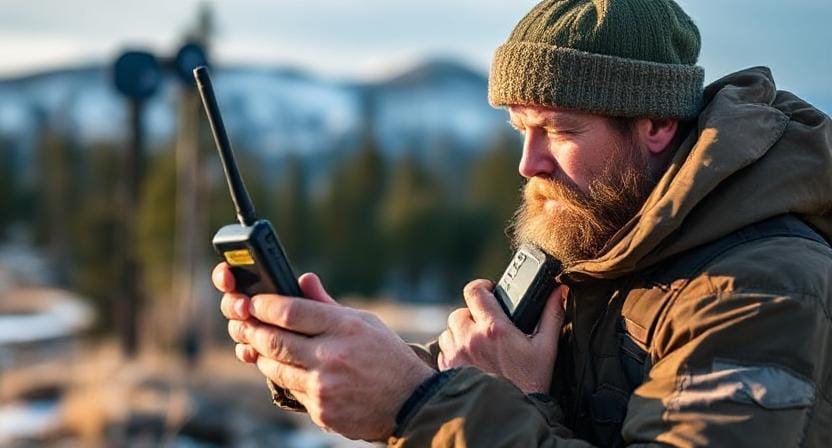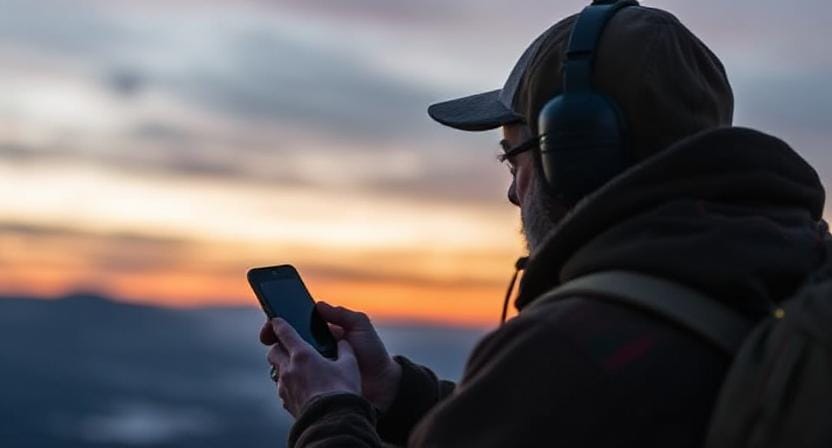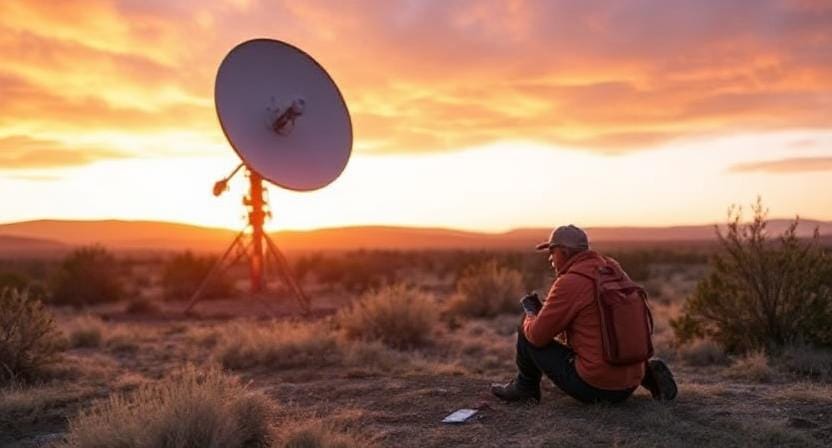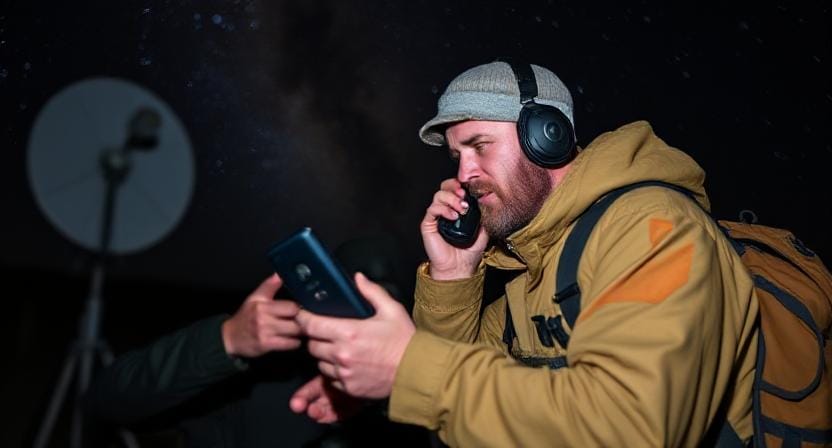Please Note: This post may contain affiliate links. If you click one of them, we may receive a commission at no extra cost to you. As an Amazon Associate, I earn from qualifying purchases.
Last Updated on November 2, 2025 by Kevin Collier

Top Takeaways and Key Concepts
- Keep a fully charged satellite phone accessible for off-grid emergencies.
- Choose a phone with long battery life, light weight, and GPS.
- Practice using the device before trips to ensure quick, confident operation.
- Make calls from open areas with unobstructed sky for optimal signal.
- Establish emergency protocols: contacts, check-in times, and simple signal codes.
Imagine being in the outdoors and taking in all the beauty around you. You may hear birds chirping and see tall trees. Then, uh-oh, your friend trips over a root and falls into a bush. He is moving his arms and legs around like a fish that doesn't know what to do. It's funny, but then you realize, oh crap, there's no mobile service!
What's next? You wish you had a satellite phone. Those items are really like magic wands. When nothing else works, they can connect you to the outside world. Picture being able to receive help or guidance even if you're miles from anywhere. That's quite cool, isn't it?
Using a satellite phone isn’t hard. First, make sure it’s charged. That’s super important. You don’t want it dying right when you need it.
Find a good spot. Sometimes, just stepping a little away from trees helps. Hold it up high—like you’re trying to reach for the stars. It can take a minute to connect, so don’t panic. Just breathe!
Once it’s connected, talk clearly. Just say what you need. Help, location—whatever it is. And remember, it’s a great idea to practice using it before you really need it. You wouldn’t want to be all flustered when your buddy needs rescuing.
So, if you ever find yourself lost, out in the wild, don’t forget that little gadget can save the day. It’s one of those things that turns an adventure from scary to safe. How nice is that? Keep it handy, and you’ll be ready for anything!
Understanding Satellite Phones

Before we get too far ahead of ourselves, let’s clarify what a satellite phone is. In simple terms, it's a device that connects directly to satellites orbiting the Earth instead of relying on cell towers.
*** Shop for Survival Gear - Tools - Kits ***
Survival Gear - Bags and Backpacks - Knives - Boots/Footwear - Communication
Outdoor Cooking - Gloves - Hydration - Dry Boxes - Water Filtration Systems
Tents - Sleeping Bags - First Aid Kits - Multi-Tools - Flashlights - Fire Starters
Navigation - Survival Food - Night Vision - Headlamps - Stun Guns - Binoculars
This means that as long as you have a clear view of the sky—like during an epic camping trip—you can make calls from virtually anywhere.
Now, why would anyone want one? Well, imagine being lost in the wilderness or stuck on a mountain after taking “just one more selfie” at the edge of a cliff (we’ve all been there).
A satellite phone can be your lifeline back to safety and sanity. They’re particularly useful for adventurers who venture off-grid where traditional communication methods fail faster than my attempts at cooking gourmet meals over an open fire.
Choosing the Right Satellite Phone

Not all satellite phones are the same, so let's see. Some are made to be used a lot, while others could feel more like toys that might not last long.
When choosing one for your next trip, think about things like battery life, weight (since carrying anything heavier than your backpack is simply mean), and whether it can send messages or check emails (even in an emergency).
Some models also have built-in GPS functions that let you tell loved ones or rescue crews where you are if things go wrong. This is like sending out an SOS signal without having to use smoke signals or Morse code, which I still have trouble with.
How to Set Up Your Satellite Phone

So you acquired a brand new satellite phone. What do you do now? First things first: read the instructions! I realize that manuals might be boring and appear as interesting as watching paint dry, but trust me, they often have important information that will help you avoid unintentionally calling your ex when you need to reach emergency services.
Once you know how to use it (and don't chuck it across the room in anger), you'll want to establish up contacts before you go to places where you can't get help. It's a lot easier than trying to remember everyone's numbers while you're freaking out because your pal is still stuck in those bushes!
Also, don't forget to charge that baby! Check that its battery is full before going to places where power outlets are harder to discover than Bigfoot performing yoga.
Making Calls Like A Pro

When you're finally ready to make calls using your satellite phone—whether it's calling for help or just letting someone know you're alive—it helps to understand how best to position yourself for optimal reception.
Unlike regular phones where sometimes holding it above your head while standing on one leg does wonders (don’t ask me how I know), satellite phones require an unobstructed view of the sky.
So, find an open area away from tall trees or mountains blocking those precious signals! If possible, stand on top of something high; I mean who doesn’t love feeling like King Kong every once in a while?
And don’t forget: speak clearly! The connection may not be crystal clear due to atmospheric conditions or distance from satellites—so take deep breaths and channel your inner radio announcer when talking.
Emergency Protocols
Honestly speaking, having protocols in place can save time and confusion during emergencies. Before heading out on any adventure involving potential risks (like hiking near cliffs or inviting friends who think they’re experts at everything), gather everyone together for a quick briefing session about how and when they'll use these devices.
Establish guidelines such as:
– Who Do We Call First? Decide beforehand whom you'll contact first during emergencies.
– Check-In Times: Set specific times throughout your trip when everyone will check-in via their sat phones.
– Signal Codes: Create fun codes so people understand what's happening without needing lengthy explanations (“Code Red” could mean “lost,” while “Code Blue” indicates “snack time”).
These simple steps ensure smooth communication under pressure!
Maintenance Tips
On the other hand—and let’s be fair here—you’ll want your satellite phone working well when needed most! Regular maintenance checks will help avoid surprises down the line. This includes keeping it clean since dirt particles might mess up performance faster than getting caught in rain without waterproof gear!
Also remember: store it properly between uses; extreme temperatures can damage batteries quicker than my hopes of becoming an Olympic athlete after two weeks at home binge-watching TV shows!
Lastly—but certainly not least—always keep spare batteries handy if available since nothing ruins outdoor adventures quite like dead electronics!
Frequently Asked Questions
Why use a satellite phone instead of a cell phone?
Satellite phones connect to satellites, not towers, so they work in remote places where cell signals do not reach.
What features should a survival satellite phone have?
Look for long battery life, light weight, strong reception, and helpful extras like GPS capability.
Do satellite phones need a clear signal to work?
Yes, they work best with an open view of the sky and may struggle near tall trees, cliffs, or dense structures.
Should I practice using a satellite phone before traveling?
Yes, practicing ahead of time ensures you know how to dial, transmit location, and connect under pressure.
How do I make calls properly in an emergency?
Stand in an open area, raise the device for sky clearance, stay calm, and communicate your needs and location clearly.
Is it useful to create emergency contact protocols?
Yes, establishing check-in times, designated contacts, and simple codes improves response speed and clarity.
How important is charging and battery care?
Very important—keep your device fully charged before travel and protect it from extreme temperatures to preserve battery life.
Suggested Resources:
Satellite Phone Reviews
https://www.satellitephonereviews.com
How Satellite Phones Work
https://www.howsattelitephoneswork.com
Emergency Communication Plans
https://www.emergencycommunicationplans.com
Survival Gear Essentials
https://www.survivalgearexperts.com

Kevin Collier is a seasoned survivalist and expert in prepping and homesteading, contributing to WiseSurvive.com. With a deep-rooted passion for self-sufficiency and outdoor survival skills, Kevin shares practical advice, strategies, and resources to help individuals prepare for any challenge. His informative articles cover a range of topics, from essential survival techniques to sustainable living practices, empowering readers to thrive in any situation. Whether you're a novice or a seasoned prepper, Kevin's insights will inspire you to take charge of your readiness and build resilience for the future.




